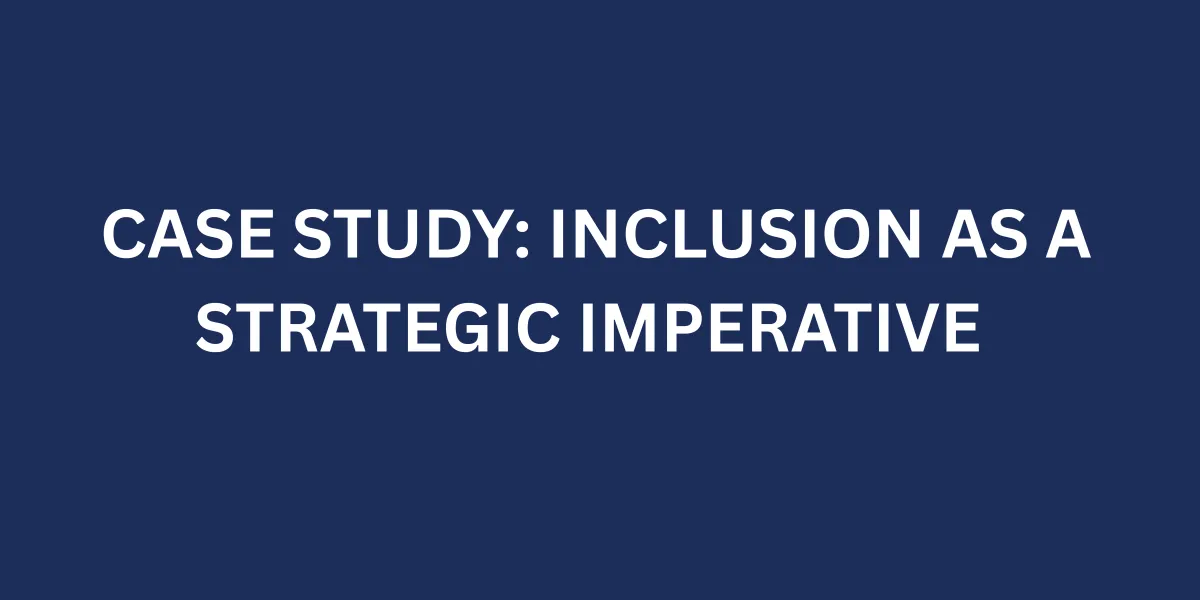
🧠Case Study: Inclusion As A Strategic Imperative
A Neuroscience-Guided Transformation Across 30 Global Locations
Organizational Context: Strategic Inclusion as a Leadership Imperative
A global leader in enterprise software and data analytics identified a structural issue undermining its innovation capacity despite having diverse talent pipelines, and unconscious bias was persistently affecting decision making quality across hiring, feedback delivery, and team collaboration.
Observations:
Limited heterogeneity in final candidate pools despite diverse sourcing
Dominance behaviors inhibiting psychological safety and idea generation
Variability in feedback practices contributing to equity gaps.
Recognizing that inclusion drives innovation, the company sought a solution not rooted in compliance training but in durable behavioral change grounded in cognitive science.
🎯 Intervention Goal: Interrupt Bias in Real-Time Through Cognitive Repatterning
Target Population: 3,500 leaders and influencers across 30+ countries.
Objectives:
Enhance capacity to detect and override biased cognitive heuristics
Reinforce inclusive habits via distributed, scalable learning
Foster environments aligned with SCARF (Status, Certainty, Autonomy, Relatedness, Fairness) - a social neurobiology framework linked to trust and engagement.
🔬 Solution: A Neuroleadership Intervention
Core Neuroscience Principles used for Intervention:
System 1 vs System 2 Thinking: System 1 is the automatic, fast, and emotion-driven, whereas System 2 is slow, deliberate, and logical. Leadership Relevance: Leaders must shift from reactive decision making (System 1) to reflective processes (System 2) during hiring, performance reviews, and conflict resolution especially when the stakes are high.
Neuroplasticity: The brain can rewire through repetition, forming new neural pathways. Leadership Relevance: Repeated use of inclusive practices (e.g.. question assumptions, expanding perspectives) fosters lasting habit change turning episodic interventions into embedded leadership capability.
Cognitive Inhibition: The brain suppresses habitual responses via prefrontal cortex activation. Leadership Relevance: Leaders override biases and default heuristics by pausing and applying cognitive control which is critical during unconscious bias interruption and emotionally charged decisions.
Threat Response: Social threat triggers activate the amygdala and inhibit executive functioning. Leadership Relevance: In Inclusive environments, leaders reduce threat triggers allowing others to engage more productively and take interpersonal risks.
Delivery Architecture: Behavior Learning Ecosystem
The company deployed a tailored modular digital learning experience that is optimized for cognitive engagement and habit retention.
Microlearning Modules (5-7 mins): Each targeting one neuroscience principle using episodic and semantic encoding
Contextual Prompts: Weekly nudges (Slack / Email) priming memory recall at decision junctions (e.g.. interviews and 1:1s)
Pulse Surveys: Measuring behavioral frequency, perceived cognitive load, and barriers to execution
Virtual Learning Labs: Reinforcing social learning through peer exchange and metacognitive reflection
This scientifically informed design accomplished 3 things:
Spaced repetition strengthened myelination of newly learned behaviors
Social reinforcement activated reward circuits, which increased habit stickiness
Cognitive Reframing lowered limbic resistance to change.
📈 Outcomes: Neurobehavioral Change at Scale
6 Month Post Implementation Metrics:
Tool usage: 85% of leaders used the tools weekly; 67% applied in high stakes decisions
Behavior Shift: Increase in diverse interview panels, inclusive meeting design, and evidence based feedback templates
Cultural Impact: Allyship rose, underrepresented talent mobility increased, inclusion scores rose by 10-14% in 3 departments.
🔍 Comparative Advantage: Applied Neuroscience vs Traditional DEI
This approach reflects a shift from "training about bias" to "training the brain to interrupt bias" a fundamentally different paradigm with implications for leadership identity, team dynamics and equity architecture.
🧠 Strategic Insights for Corporate Application
Evidence Based Simplicity Scales: 5 steps enable quick cognitive activation during leadership moments.
Neuroscience Drives Executive Buy In: Grounding inclusion in brain science reframes it as a performance enabler, not a moral appeal.
Behavioral reinforcement is non negotiable. Weekly nudges and peer accountability anchor neural rewiring.
🧭 Phase Based Rollout Strategy for the Program
Total Timeline: 6-8 Months (Full Cycle)
This includes scoping, stakeholder alignment, development, implementation and behavioral measurement.
This transition positions inclusion not as an HR program but as a neural leadership capability hardwired into operational architecture.
-----------------------------------------------------------------
Ready to Implement Neuro-Inclusive Leadership In Your Organization?
If your organization is still relying on bias awareness seminars, it may be time to evolve. Let's co-design a neuroscience based coaching program that builds leadership capability from the brain outward, driving durable cultural change and business resilience.
Contact Neuro Elevate Solutions to integrate this program into your strategy. Because Inclusive Leadership isn't optional - it's neurobiologically essential.
